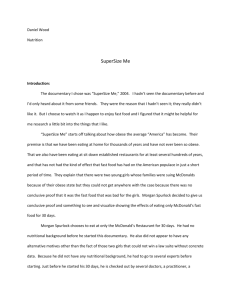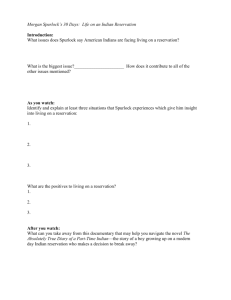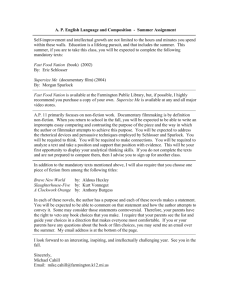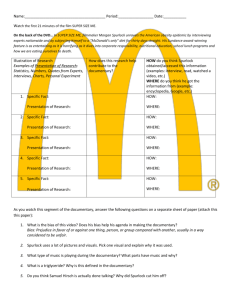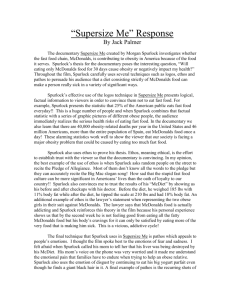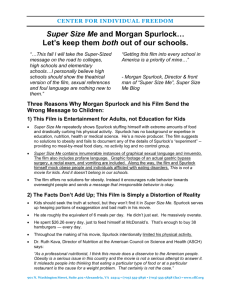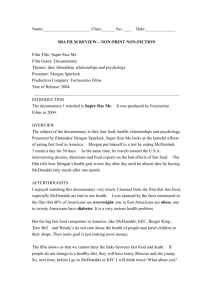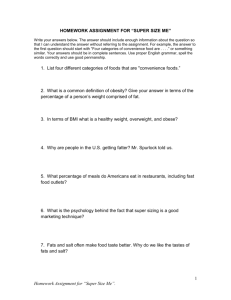Rhetorical Analysis of Supersize Me
advertisement
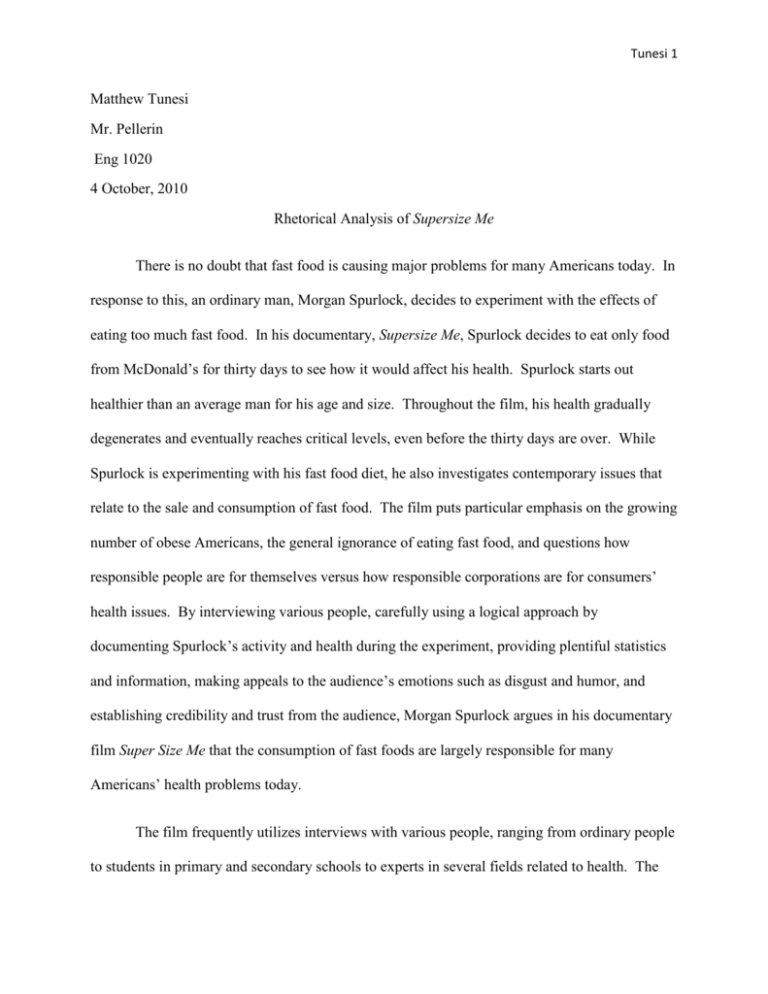
Tunesi 1 Matthew Tunesi Mr. Pellerin Eng 1020 4 October, 2010 Rhetorical Analysis of Supersize Me There is no doubt that fast food is causing major problems for many Americans today. In response to this, an ordinary man, Morgan Spurlock, decides to experiment with the effects of eating too much fast food. In his documentary, Supersize Me, Spurlock decides to eat only food from McDonald’s for thirty days to see how it would affect his health. Spurlock starts out healthier than an average man for his age and size. Throughout the film, his health gradually degenerates and eventually reaches critical levels, even before the thirty days are over. While Spurlock is experimenting with his fast food diet, he also investigates contemporary issues that relate to the sale and consumption of fast food. The film puts particular emphasis on the growing number of obese Americans, the general ignorance of eating fast food, and questions how responsible people are for themselves versus how responsible corporations are for consumers’ health issues. By interviewing various people, carefully using a logical approach by documenting Spurlock’s activity and health during the experiment, providing plentiful statistics and information, making appeals to the audience’s emotions such as disgust and humor, and establishing credibility and trust from the audience, Morgan Spurlock argues in his documentary film Super Size Me that the consumption of fast foods are largely responsible for many Americans’ health problems today. The film frequently utilizes interviews with various people, ranging from ordinary people to students in primary and secondary schools to experts in several fields related to health. The Tunesi 2 interviews are particularly effective because they get the point of view on a topic from several different people. The interviews with ordinary people are anonymous and conducted in the streets of a city. Spurlock asks these people questions such as how much fast food they regularly consume, their favorite fast food restaurants, and how often they think people should eat fast food. The interviews with students are also anonymous. In an interview with young primary school students, Spurlock sees how familiar they are to certain images of various people, both real and fictitious. Some of the students interviewed are unable to recognize George Washington, and those that do have little knowledge about the famous historical figure. None of the students are able to recognize an image of Jesus Christ. However, all of the students are able to recognize an image of Ronald McDonald, and also know a lot about him as well. In an interview with secondary school students, Spurlock asks the students if they know the definition of a calorie. None of them are able to define a calorie correctly. When Spurlock asks ordinary people to define a calorie, none of them can do so either. Finally, an interview with an expert reveals the definition of a calorie. The purpose of these interviews is to show the general ignorance of people and emphasize the seriousness of this problem. The interviews are rather convincing because they seem to be legitimate and original; that is to say, it is evident that the interviews are really showing peoples’ true thoughts on the questions asked, and that the interviews are not scripted. This is actually confirmed when, during an interview with a representative from the fast food corporations, the representative is caught saying something contradictory to his case. In addition to several interviews, the film also follows a logical order. Whenever Spurlock is shown ordering or eating a meal from McDonalds, the scene is always labeled with a day number. For example, before Spurlock is shown eating his first McDonald’s meal, the film Tunesi 3 shows the phrase “Day One”. This is done to give the audience perspective on how long Spurlock has been on the diet and the medical effects it has on him. This helps move the film along well and allows the audience to see how Spurlock’s activity progresses with the film. The film also shows Spurlock in several medical examinations, starting with preliminary exams and followed by several other periodic check-ups. During these check-ups, medical information such as Spurlock’s weight and his cholesterol level are revealed to show the audience the effects the diet has on Spurlock’s health. Each successive medical check-up reveals that Spurlock’s health is getting worse. However, Spurlock’s health gets worse than anyone had expected, and before the end of the thirty day period, Spurlock is in critical condition. This proves the harmful effects of eating too much fast food. The film also documents Spurlock’s feelings that result from his health. Spurlock gradually gets tired and moody, and he also shares how he is feeling several times with the audience. This allows the audience to see how the fast food diet is affecting him emotionally as well as physically. In addition, the film is logical in that it uses many statistics to prove Spurlock’s arguments throughout the film. The film uses statistics in every part of the movie, from the number of McDonald’s establishments in Manhattan, New York City, to the amount of money corporations spend on advertising their products each year. The information not only gives knowledge to the audience, but it also helps the audience realize the severity of some of the problems the film addresses. While there is a lot of information revealed in the film, the information is used in a logical manner that is easy for the audience to follow. For example, during interviews with experts, the film sometimes stops the interviews and then uses statistics to either support or contradict what the expert has to stay. By doing this, the audience can understand that even experts can be wrong or have opinions that differ from some statistics. The Tunesi 4 film also uses information to surprise the audience about a certain subject. For example, the film addresses the availability of supposedly healthy alternatives to sides from fast food restaurants, such as yogurt parfaits or salads. However, Spurlock will then explain that these alternatives are actually not much healthier, if even at all healthier. This is done to effectively argue to the audience that, within reason, there really are no healthy foods available at fast food restaurants. This really shows that there is no way to eat at a fast food restaurant and expect to have a healthy meal. The film also uses emotional appeals to make many arguments throughout the film. These emotional appeals are usually intended to be disgusting scenes. For example, on just day two, Spurlock is asked to supersize his meal. Based on his established rules, he must agree to supersize his meal and eat the entire meal, no excuses. He does eat the entire meal (which takes him about 20 minutes), only to vomit out of his window immediately afterward. The cameraman then films the vomit on the ground in the parking lot. This is a strong emotional appeal toward disgust that argues to the audience that supersize meals are just way too much for an average person to eat. The film also makes appeals to disgust when Spurlock shows that he had a hair in a yogurt parfait, implying that foods are not always carefully prepared at fast food restaurants. The film also shows sugar and fat in containers equivalent to the amount of those substances Spurlock consumed in the food he ate during the thirty day period, giving the audience a clear visual perspective on what was in the food he ate during the diet. The strongest emotional appeal to disgust of all was the filming of a gastric bypass surgery; and while the surgery is being shown, it is accompanied by the classical piece “The Blue Danube” playing in the background. This scene was shown to reveal to the audience what fat looks like in the body and how much Tunesi 5 can be found in the body of an obese person as well. The classical music piece helps make the scene even more emotional for the audience. Although Supersize Me is a serious film, it has many elements of humor and comic relief that lighten up the film as well. The film includes humorous songs and pictures that poke fun at the McDonald’s corporation and their mascot, Ronald McDonald. The songs intentionally have humorous lyrics that are poorly sung to make fun of McDonalds. At the beginning of almost every chapter of the film, a drawing of Ronald McDonald is shown that relates to the topic of the chapter in a comical manner. For example, at the beginning of the chapter titled “The Last Supper”, a parody of the famous scene from the Bible is shown with Ronald McDonald in the center of a long table surrounded by well known cartoon characters. In front of Ronald McDonald are a hamburger, fries, and a soft drink. These songs and illustrations help make the film move along more smoothly by providing the audience an opportunity to laugh and enjoy some humor while watching the film. Spurlock’s personality plays a large role in the film as well. Throughout the film, Spurlock is serious in an informal way. This is done so that the audience can relate to Spurlock emotionally, as if they personally knew him. Spurlock often acts in a humorous, light-hearted way when he is eating and ordering food. This is done to create comic relief to the film. Also, a few scenes in the film aren’t entirely relevant to the arguments the film is making, but instead are meant to make the audience laugh. Spurlock often makes several humorous remarks throughout the film. By conducting interviews, medical check-ups, and providing the audience with information, Spurlock shows concern and gives the audience the impression that he knows what he is talking about. Therefore, Spurlock earns respect and establishes credibility at the same time, which makes his arguments even more effective. Tunesi 6 Spurlock also establishes credibility by analyzing the fast food corporations’ point of view on the issues addressed in the film. Spurlock explains the corporations’ way of justifying their business and even defending against allegations that their products are causing consumers’ medical issues. For example, Spurlock explains that the McDonald’s corporation stated that fast food can actually be a part of a healthy diet. Also, Spurlock interviews a representative from a corporate lobbyist organization that defends the interests of several major food and beverage corporations. However, Spurlock then challenges the corporations’ opposition to his arguments by showing the audience information that contradicts the corporations’ claims. This further strengthens Spurlock’s arguments by showing that some of the opposition’s arguments are not entirely valid. Furthermore, Spurlock puts an interesting twist to the film and its arguments when he interviews a man named Don Gorske. Gorske is a Big-Mac enthusiast who, as of the filming of Super Size Me, had eaten 19,000 Big Macs in his life. According to Gorske, he usually eats two or more Big Macs a day and they account for the majority of his food intake. Despite eating so many Big Macs in his life, Gorske is still a very healthy and physically fit person. The purpose of interviewing Gorske was to show that out of all the people who get unhealthy from consistently eating fast food, there are always rare exceptions. However, because Gorske only eats Big Macs from McDonalds without sides or drinks, it also shows that sides and drinks are largely responsible for the extremely high amount of calories in a fast food meal. This lets the audience realize that one actually can be healthy while eating a fast food diet, but it would have to be a diet that would probably be impractical to most people. In his documentary film, Super Size Me, Morgan Spurlock makes the argument that fast food is not only unhealthy to eat, but is a leading cause for many Americans’ health problems. Tunesi 7 Spurlock makes appeals to all three parts of the rhetoric triangle in the film to make his arguments stronger and more effective. Spurlock gives the audience plenty of information and statistics to logically prove his points, and uses these statistics at the most appropriate moments to make his arguments stronger. He also appeals to the audience’s emotions by showing the audience rather disgusting scenes such as the gastric bypass surgery and showing how much sugar and fat he consumed during his thirty day diet. He also includes several pictures, songs, and scenes that are intended to make the audience laugh in an attempt to provide comic relief to the film. Spurlock also establishes credibility by interviewing several different people, from ordinary people to experts, on the various issues addressed in the film. He also acts informally, but at the same time serious in order to make him closer to the audience, but still make effective arguments. Lastly, he also makes appeals to ethos by addressing the counter-arguments made by corporations and interviewing someone who consistently eats McDonald’s but is still a healthy person. Overall, Spurlock makes use of good rhetoric to make very effective and convincing arguments about the dangers of eating too much fast food. The over-consumption of fast foods is a very real and very serious problem for many Americans today. Spurlock makes it evident that people need to realize what they are eating and how much exercise they are getting. He also warns that consumers must avoid being convinced to eat more fast food than they actually should by not giving in to advertisements for fast food. While the over-consumption of fast food is a big problem, it is also easily avoided or solved if people take it upon themselves to eat healthier, exercise more, and be aware of the dangers of eating too much fast food. That is the purpose of Morgan Spurlock’s documentary Supersize Me. Tunesi 8 Works Cited Spurlock, Morgan, dir. Supersize Me. THE CON, 2004. Film.
